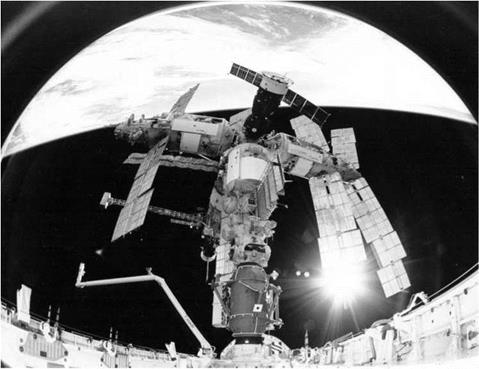STS-74
|
Int. Designation |
1995-061A |
|
Launched |
12 November 1995 |
|
Launch Site |
Pad 39A, Kennedy Space Center, Florida |
|
Landed |
20 November 1995 |
|
Landing Site |
Runway 33, Shuttle Landing Facility, KSC, Florida |
|
Launch Vehicle |
OV-104 Atlantis/ET-74/SRB BI-076/SSME #1 2012; #2 2026; #3 2032 |
|
Duration |
8 days 4 hrs 30 min 44 sec |
|
Call sign |
Atlantis |
|
Objective |
Mir docking mission; delivery of Russian-built Docking Module |
Flight Crew
CAMERON, Kenneth Donald, 45, USMC, commander, 3rd mission Previous mission: STS-37 (1991); STS-56 (1993)
HALSELL Jr., James Donald, 39, USAF, pilot, 2nd mission Previous mission: STS-65 (1994)
HADFIELD, Chris Austin, 36, Canadian Air Force, mission specialist 1 ROSS, Jerry Lynn, 47, USAF, mission specialist 2, 5th mission Previous missions: STS 61-B (1985); STS-27 (1988); STS-37 (1991); STS-55 (1993)
McARTHUR Jr., William Surles, 44, US Army, mission specialist 3
Flight Log
Because of the planned rendezvous and docking with Mir, this Shuttle mission had only a very small seven-minute window in which to launch. The 11 November launch was scrubbed as a result of bad weather at the TAL sites and the launch was rescheduled to the following day. The original plan had been to have a crew exchange on this mission. Thagard’s back-up on the first NASA residency (Bonnie Dunbar) was originally scheduled to remain on Mir after STS-71 departed, but this option was not followed, so STS-74 was the only docking mission on which no US astronaut was exchanged or returned. Instead, the mission focused on the delivery of hardware and logistics. It did feature an international flavour, however, reflecting the plans for ISS in the coming years. Canadian astronaut Chris Hadfield was part of the Shuttle crew, and the Canadian-developed RMS was carried once more. The payload bay of Atlantis carried the Russian-built Docking Module and solar array, along with the US-built Orbiter Docking System and a joint US/Russian-built solar array. And of course, on board Mir were the two Russian and one German cosmonaut, together with a range of Russian and European equipment and experiments.
|
Atlantis is seen docked with Mir high above central Canada in this IMAX camera image, which provides this 65-mm fish-eye perspective. The recently delivered Docking Module is shown connecting the Shuttle to Mir and affording better clearance for Shuttle dockings |
The Russian Docking Module (which, when permanently attached to the Kristall module would give better clearance for further Shuttle dockings) was lifted out of the payload bay by Hadfield, who was operating the RMS. It was positioned just above the Orbiter Docking System, carried on all docking flights at the front of the payload bay to permit physical connection between the Shuttle and the space station. Cameron then fired the downward-facing jets on the Shuttle to move the vehicle “up” to dock, with the Docking Module held on the RMS. The docking between the Docking Module on Atlantis and Mir occurred on FD 4 and for the next three days, the crews of Atlantis and Mir completed a joint programme of activities. This included the transfer of the control of the DM to the main Mir crew. There was also 453.6 kg of water transferred across to the station, along with gifts such as Canadian maple leaf candies and the second guitar to be delivered to the station. New lithium hydroxide canisters were also delivered, which would be used in the event of a further failure of the ECS, requiring further “scrubbing” of the air inside the station. Experiment samples were transferred to Atlantis for the return to Earth and on 18 November, Atlantis separated from the DM to begin its fly around of the station and the journey home, leaving the Mir crew to continue their six-month mission.
In January 1996, NASA pronounced itself happy with the success of Shuttle-Mir missions. Continued discussions with the Russians had resulted in expansion of the programme and two further dockings were included in the Phase 1 programme, bringing the total dockings to nine. Two further long-duration visits by American astronauts were also likely, bringing the total US residencies on the station to seven prior to the commencement of ISS construction.
Milestones
184th manned space flight 103rd US manned space flight 73rd Shuttle mission 15th flight of Atlantis 2nd Shuttle-Mir docking mission











